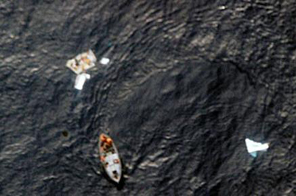More bodies found from AF crash
RECIFE: Brazil's navy recovered more bodies Sunday from an Air France jet that plunged into the Atlantic nearly a week ago, as investigators probed a possible link between false speed measurements and the crash. Skip related content
Three more bodies were snatched from the waves 1,000 kilometers (600 miles) off Brazil's northeastern coast and operations were underway in "unfavorable" weather to recover others spotted floating among seats and other debris from the plane, Brazilian military officials said.
The latest finds followed the recovery on Saturday of the first two bodies from Air France flight AF 447, which came down early June 1 with 228 people on board. The plane left from Rio de Janeiro to Paris a week ago, on May 31.
The sex of the three recovered bodies could not be determined, Brazilian air force spokesman Lieutenant Colonel Henry Munhoz said, suggesting how bad a condition they were in after seven days in the water.
"Their state will not be revealed because it's not in the public interest," he said.
A navy frigate was to take the bodies and items recovered on Saturday including an Air France seat, a briefcase with an Air France ticket and a backpack, to the nearest port of Fernando de Noronha, a Brazilian archipelago 400 kilometers offshore.
Three more police experts arrived on the island for preliminary identification work during which they will collect basic information, such as the state of the bodies and any clothing, according to air force spokesman Jorge Amaral. Five other police experts arrived Saturday.
The ship was expected to arrive Monday. From there, the remains were to be flown to the mainland city of Recife, where search operations were being coordinated and a morgue had been set up to identify the bodies through DNA tests.
Munhoz said "some 100 objects" had been spotted in the crash zone, including other seats emblazoned with the Air France logo and oxygen masks. But the priority was the recovery of the bodies.
The black boxes from the plane have not yet been found.
A French navy frigate on Sunday joined the search effort. Two French military aircraft were already flying with the 12 Brazilian air force planes at work in the area.
Two French submarines, including one that explored the wreck of the Titanic and another, nuclear powered military ship, were also on their way to hunt for the devices, which will stop transmitting their location in three weeks' time.
With clues still being pieced together over the crash, speculation is focusing on its airspeed monitors.
The doomed jet broadcast a series of 24 automatic error messages as its systems shut down one after the other in its final minutes, and French accident investigators say the cockpit was receiving conflicting speed data.
Following the crash, planemaker Airbus warned pilots to review their procedure to cope with this problem.
Air France said on Saturday it had accelerated plans begun April 27 to replace the monitoring units in its jets after noticing problems with airspeed information on its Airbus A330s and A340s since May last year.
It insisted in a statement that this should not be taken as prejudging the result of the crash investigation.
The device in question is the pitot probe, usually on the leading edge of a wing, which measures the force of the air through which an aircraft passes and thus calculates how fast the plane is going.
France's transport minister Dominique Bussereau said it was too early for investigators to say what was the most likely cause of the crash, but confirmed that Airbus jets had experienced problems with speed monitors.
"There have been situations on Airbus planes, and perhaps on others, where these probes ice up in a very wet area, a deep depression, an area of storms, and no longer give the correct speed reading," Bussereau told France's RTL radio.
"It's obvious that if the pilots in the cockpit no longer have the correct speed ... that can lead to two bad consequences for the survival of the plane," he explained.
"Too low a speed, which can cause it to stall, or too high a speed, which can lead to the plane ripping up as it approached the speed of sound, as the outer skin is not designed to resist such speed."






